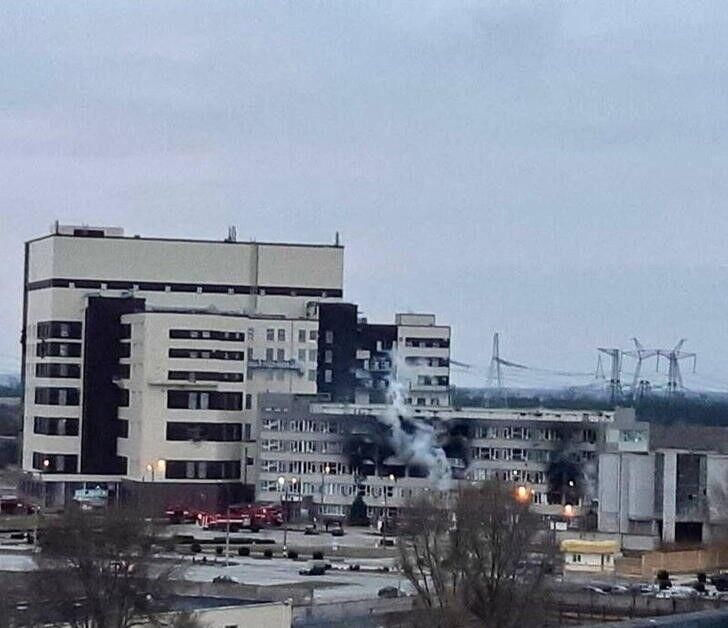What experts say an attack on a Ukrainian nuclear power plant could do
By Matt Field, Susan D’Agostino | March 4, 2022
 A damaged administrative building of the Zaporizhzhia nuclear power plant in Enerhodar, Ukraine, in a handout picture released on Friday. Credit: Energoatom/Via New York Times
A damaged administrative building of the Zaporizhzhia nuclear power plant in Enerhodar, Ukraine, in a handout picture released on Friday. Credit: Energoatom/Via New York Times
Russian forces attacked Europe’s largest nuclear power plant yesterday sparking worldwide concern about a nuclear disaster. While a fire burned at a training building at the Zaporizhzhia nuclear plant, the reactors there were not damaged. The worst-case scenario, a direct hit on radioactive material at the plant, seems to have been avoided.
An attack on the nuclear material at a power plant could release cancer causing radioactivity at least within Ukraine, experts said Friday. Some of the scenarios that might occur during an attack on a nuclear plant include a direct hit, such as a missile strike, that damages the reactor; a strike on a pool where spent nuclear fuel is cooling; or an attack that disrupts the electrical supply to the plant and affects the systems that keep the nuclear core of a reactor cool. “There’s a number of ways this can go very bad,” Allison Macfarlane, a former chairman of the US Nuclear Regulatory Commission, said.
Robert Rosner, a physicist at the University of Chicago and a former chair of the Bulletin’s Science and Security Board, said the biggest risk in his view is a strike on a spent fuel pool containing many used fuel assemblies. The spent fuel pools are often less protected than the reactor itself, Rosner said. “A missile hitting the spent fuel pool would be really pretty bad news,” he said.
Once news of the Russian attack broke, some officials in Ukraine speculated that a crisis bigger than the 1986 Chernobyl nuclear disaster was brewing. But there are differences between the Zaporizhzhia plant and the Chernobyl plant. The Zaporizhzhia plant has highly reinforced containment structures for their reactors; the Chernobyl reactor had no such structure. Also, newer nuclear reactors do not use graphite as a material to moderate the nuclear reaction in its core; the older Chernobyl reactor design did use graphite, which ignited when the core overheated.
The graphite fire at Chernobyl is what sent radioactive material high into the atmosphere and then across Europe. A strike on the Ukrainian plant, Rosner said, would have caused more localized risk. “In this case it’s just the explosion that spreads (radioactive material),” he said, “so this material is not going to get very high in the atmosphere.”
But another nuclear power expert, M.V. Ramana of the University of British Columbia, doesn’t think that Ukrainian President Voldymyr Zelensky was being overly alarmist when he speculated that an attack on Zaporizhzhia could have been worse than Chernobyl.
“Everything could have been possible, right? In hindsight, you might look at and say, ‘Oh, they were not really targeting the reactor.’ But we don’t really know,” Ramana said. “Had the battle gone on in a different way, it’s quite possible that they may have hit something much more sensitive.”
In any case, a strike on a nuclear reactor would cause big problems, Macfarlane said. “If you hit the reactor vessel itself … and you punctured it or something, you’d lose water, and you’d have a loss of coolant event and melt the fuel. I assume you would breach the containment as well, and then you’d definitely have a massive release of radiation,” she said.
Nuclear plants require a constant source of electrical power to maintain the systems that cool nuclear fuel in the reactor and the spent fuel pools by circulating water. Plants have diesel generators to provide backup electricity, if necessary. A strike that knocks out offsite electricity to the plant and backup generators could cause a major problem leading to radiation releases, experts say.
“In the event that the grid fails, then usually there are diesel generators on site, and these supply backup power,” Ramana said. “But if these are occupied through military action, one can easily imagine these being damaged as well, in which case there may be an absence of cooling completely. And that could lead to a meltdown, sort of what we saw in Fukushima.”
Macfarlane is also concerned about the overall effect the war in Ukraine on the people that work at the country’s nuclear plants. Even plants that are shut down need people to continuously ensure that a variety of systems, including those that keep used nuclear fuel cool, are operating. She said that plant operators during wartime might “decide to go and protect their families.” Under stressful circumstances, they might not be getting enough rest.
“These reactors are different from natural gas plants because they need a lot of care and attention,” she said. “I mean, you can imagine lots of different scenarios where you’ve got problems.”
Zaporizhzhia is now in Russian hands. But there are three nuclear power plants in Ukraine that the Russian military has not yet taken, and, experts worry, more opportunities for the war to skirt—or cause—nuclear disaster. “This is uncharted territory,” Ramana said. “We have never had so many reactors in a battle zone. The act of attacking a reactor should not be within the purview of any military plan.”
Together, we make the world safer.
The Bulletin elevates expert voices above the noise. But as an independent nonprofit organization, our operations depend on the support of readers like you. Help us continue to deliver quality journalism that holds leaders accountable. Your support of our work at any level is important. In return, we promise our coverage will be understandable, influential, vigilant, solution-oriented, and fair-minded. Together we can make a difference.
Keywords: Russia, Ukraine, Zaporizhzhia
Topics: Nuclear Risk
















Publicizing the actual work done by the brave Ukrainian scientists who have worked for many years on issues of radiation protection and radiation detection issues needs to be done. The scientific research of scientists like Igor Cherniavskiy, Volodymyr Viinikov, Segey Petrukhin and V.P. Starensky provides insight into these important issues and should not ignored.
If the articles by these and other Ukrainian scientists are not available through the internet I will be glad to provide electronic copies to those interested.